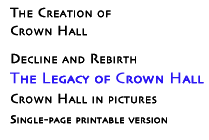

  |
||||
|
|
The Legacy of Crown Hall -by Lynn Becker After a major restoration, Crown Hall is as relevant - and controversial - as ever.. |
|
||
|
For many architects, this is all much too anal. They respond to Mies as they would to a bad rash. In our liberated, all-accepting time, where excess is seldom enough, Mies's linear, controlling and demandingly simple architecture seems a relic of a despotic age. Did not Mies. himself, once say back in 1924 that, " We are concerned today with questions of a general nature. The individual is losing significance, his destiny is no longer what interests us.” In our own era, one of relentless privitization and unfettered power and ego, this reads as blasphemy, but it may be a truer assesment of our current state than we may care to admit. Today, technology gives us instantaneous access to a wealth of information that previous generations couldn't even imagine. In his book Everything Bad is Good For You, author Steve Johnson argues that video games increase problem-solving skills and SAT scores, that audiences today can easily follow movies with complicated plot lines and a jump-cut switching from one story to the next that would have left a viewer in the 1930's - or even 60's - completely lost and befuddled. The CBS newsmagazine 60 Minutes recently ran a story on the "Echo Boomers", the offspring of the Baby Boom generation, as the most wired generation ever, with computers, Ipods, cell-phones and instant messaging. Does this inexhaustible universe of choice represent a liberation, or a cultural addiction to diversion that ultimately, through the magician's hoary trick of misdirection, becomes a potent weapon of political control? During the 60 Minutes segment, noted pediatrician Mel Levine related how he had asked an employer to characterize his young hires, and got this reply: "They can't think long-range. Everything has to be immediate, like a video game. And they have a lot of trouble sort of doing things in a stepwise fashion, delaying gratification. Really reflecting as they go along." When it's so easy to get at answers, are we too liable to accept the first plausible-sounding response that pops up on a Google search? In the blogosphere, there are those who try to get it right, and far more who think if they believe it, it has to be right. Facts and faith both create a construct of reality. If people are willing to believe, is one any better than the other? A student of Aquinas, Mies actually believed in the idea of truth, and he seemed most at peace making drawing after drawing, trying to reveal it in his architecture. As a teacher, he took on the persona of the guy who held all the answers and dared you to pry any of them out of him - a great, wrinkled sphinx, staring out dispassionately from deeply pouched eyes, encircled in cigar smoke as if it were incense. It wasn't for everyone. Pritzker Prize-winning architect Kevin Roche, in the book Conversations with Architects, remembers his brief time studying with Mies, “His habit, which was very disconcerting, was to come and sit down. Then he would light a cigar and remain perfectly silent for two hours. No one talked. You sat there, and there was absolute silence. . . . my only reaction after one of these sessions was to go out and get a very strong drink to try to recover.” Rem Koolhaas, an acute observer of Mies and his legacy, has written, "Mies's work had an essence of formlessness, amorphouness, nothingness, perversion, and anxiety behind a stealth shield of serenity.” That's Crown Hall in a nutshell, serene and subversively unsettling. Mies doesn't try to intoxicate your senses. He's master at creating beauty, but he isn't here just to make you feel good. His buildings don't offer you an ornate mask to hide behind, but a spare, paradoxically open enclosure where, if you so choose, you can try to learn something about who you are. He's like the sculpture torso of Apollo, speaking to Rilke in the famous poem:
How do you see the Legacy of Crown Hall? © Copyright 2005-2006 Lynn Becker All rights reserved.
|
 |
|||
|
|
||||